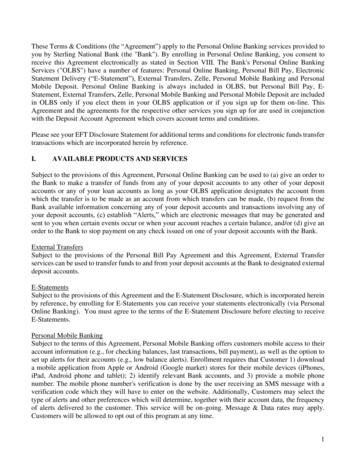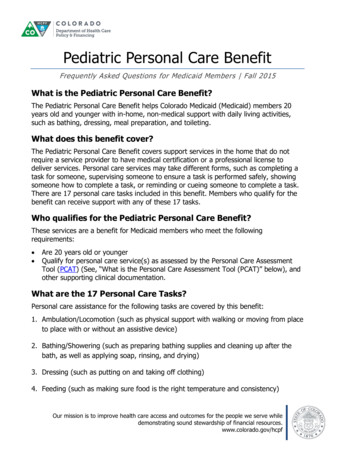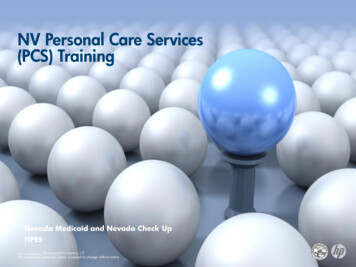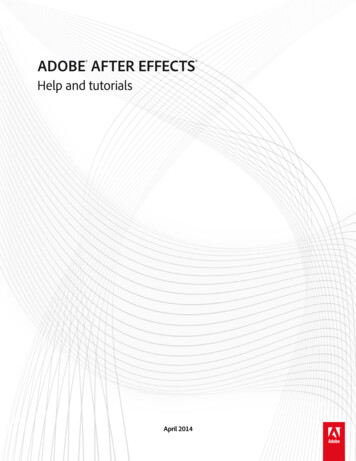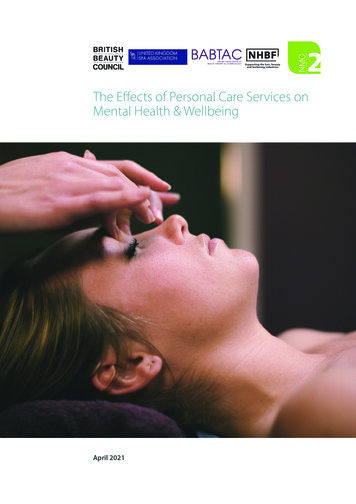
Transcription
The Effects of Personal Care Services onMental Health & WellbeingApril 2021
NMC2The Effects of Personal Care Services on Mental Health & Wellbeing.NMC2The Effects of Personal Care Services on Mental Health & Wellbeing.Table of ContentsSummary 1Recommendations 2Introduction 3The Role of The Personal Care Sector 4Touch Therapy 6Massage Therapy 6Fatigue 8Amanda WinwoodPre and Post Menopausal symptoms 8Cancer Therapy 8Return on investment 11About the Authors 12
NMC2The Effects of Personal Care Services on Mental Health & Wellbeing 1SummaryMental illness has been a growing health crisis for some time. Mental ill-health is the singlelargest cause of disability in the UK, contributing up to 22.8% of the total burden, comparedto 15.9% for cancer and 16.2% for cardiovascular disease. The wider economic costs of mentalillness in England have been estimated at 105.2 billion per annum. Mental Health problemshave increased by 8% during the pandemic.It has been estimated that optimal treatment for mental disorders will only avert 28% of theburden of mental illness.There is now significant global evidence that touch therapy, as well as massage, can have asignificant effect on reducing mental health problems. There is also evidence that it can addressfatigue, compromised immune issues, pre and post-menopausal problems and improvecancer therapy.As yet, NICE has not supported touch and massage as a therapies for mental health, citingpotential flaws with the research methodologies carried out outside of the UK. This is not to saythat the research did not show positive results.Given the potential benefits directly from personal care services to the UK economy and healthand wellbeing, the authors would recommend research be carried out in the UK to replicate thebenefits seen elsewhere.If the UK research supports the global findings, there is a potential benefit to UK plc. Even ifthe reductions in mental health problems are modest (10%), the savings to the UK would be inexcess of 10 billion per annum, reducing lost sick days by 1.76 million and sick days related tomenopause by 1.4 million.The use of touch and massage therapy has a return on investment of 15:1 as well as increasingUK productivity by 0.5%.The personal care sector is worth in excess of 30 billion and provides 600,000 jobs across theUK. 88% of the workplace is female. Within this sector, the spa industry is estimated to be worth 2.1 billion; and its qualified therapists carry out over 6 million treatments each year.Qualified therapists undertake in excess of 90 hours of training in anatomy physiology andpathologies as part of their nationally regulated qualification for entry into the workforce. Theysubsequently undertake additional continual professional development training in cancer touchtherapy, stress management and other touch therapies. The sector is well placed to supportthe NHS and Public Health to relieve issues and symptoms relating to Functional neurologicaldisorders (FND) and physical health and wellbeing through a range of therapies, improvedselfcare and preventative healthcare.
2NMC2The Effects of Personal Care Services on Mental Health & Wellbeing.NMC2The Effects of Personal Care Services on Mental Health & Wellbeing 3RecommendationsIntroductionThere is significant evidence of the benefits to mental health from touch therapies. However,these therapies are not yet routinely used in the UK and Northern Ireland within the publicand National Health Services (NHS), with access often triggered by the recipient rather than amedical professional.Wellbeing has multiple definitions depending on the body involved. Globally, the wellbeingindustry is growing at over 6% per annum and estimated to be worth over 3 trillion1. TheNational Health Service (NHS) is clear that individual wellbeing has a significant impact on lifeexpectancy, recovery from illness and is associated with positive health behaviours2. Within theNHS, there is increasing recognition that when supporting people with mental health issuesfocusing on wellbeing avoids relying on more traditional measures of mental health, suchas symptoms of illness. Indeed, many people who use mental health services consider usingsymptoms as being outdated and not in line with how they view their own wellbeing3.It is therefore recommended that a number of trials are carried out which can demonstrate thebenefits and value for money of these treatments versus those traditionally used in the UK.It is recommended that integrated health improvements should be seen as part of the toolkitfor solutions & social prescribing with existing medical services to support the NHS - with a clearstrategy, policy and funding for Primary Care Trusts to access.It is recommended that the industry accelerate the development of higher-level qualificationsbeyond English level 3 as well as creating higher qualifications (apprenticeship levels 4-7) toup-skill the workforce and improve the support of mental health and wellbeing (similar to thechanges seen in nursing qualifications which changed from State registered to degree only in2009 as the changes in skills and roles undertaken changed).Whilst the industry is recognised for funding of up to 9,000 for the new level 3 apprenticeship,it is recommended that the industry be recognised by National education funding agencies forfurther and higher education across the UK and Northern Ireland with regard to apprenticeships4 to level 7 (degree and master level), allowing SME employers to claim further funding forhigher-level standards.Mental ill-health is the single largest cause of disability in the UK, contributing up to 22.8%of the total burden, compared to 15.9% for cancer and 16.2% for cardiovascular disease. Thewider economic costs of mental illness in England have been estimated at 105.2 billion ayear4. This includes direct costs of services, lost productivity at work and reduced quality of life.In 2015, mental-health-related issues were found to lead to approximately 17.6 million days’ sickleave or 12.7% of the total sick days taken in the UK5. It is estimated that the UK GDP in 2015could have been over 25 billion (1.3%) higher if not for the economic consequences of mentalhealth problems to both individuals and businesses. Government figures show that 43% ofthose on long-term benefits due to health issues have a primary mental health problem6.Furthermore, poor mental health is associated with physical health problems. Of those with along-term physical health condition, around 30% will also have a mental health problem, andof those with a mental health problem, around 45% will also have a long-term physical healthcondition7. This has an impact on the cost of providing care, as treating the physical healthissues of patients with a mental health problem is more expensive (even after removing the costof treating the mental health issue, such as for antidepressants or mental health services)8.Early published research data on the consequences of the pandemic estimate that mentalhealth had worsened by 8.1%9. This increase was seen particularly in both young adultsand females who had mental health difficulties pre-pandemic. Overall, more than 50% ofparticipants surveyed stated they were stressed or anxious10. More recent research by AnxietyUK revealed that almost 69% of survey respondents reported their anxiety had increased orbecome severe and/or difficult to manage following the extension of last years’ lockdown11.The NHS was estimated to have spent 12.2 billion on mental health services in 2018-19 orabout 10% of its total budget. The NHS Five Year Forward View pointed out that one in four ofthe population will experience mental health problems, and that mental illness is the single1 tistics-and-facts/2 t/uploads/system/uploads/attachment data/file/277566/NarrativeJanuary 2014 .pdf3 ple-improve-it4 t/uploads/system/uploads/attachment data/file/215808/dh 123993.pdf5 health-statistics-economic-and-social-costs6 t/uploads/system/uploads/attachment data/file/213761/dh 124058.pdf7 ield/field publication idities-naylor-feb12.pdf8 Welch C A et al, Depression and costs of health care. Psychosomatics, 2009 Jul-Aug; 50(4): 392-4019 blications/52612410 blications/52612411 kdown-extension/
4NMC2The Effects of Personal Care Services on Mental Health & Wellbeing.Wealthiestlargest cause of disability. Yet mental health services have, for several decades, been the ‘poorrelation’ compared to acute hospital services for physical conditions12. It has been estimatedthat optimal treatment for mental disorders will only avert 28% of the burden of mental illness13,highlighting the need for prevention and public health services.The Office of National Statistics (ONS) estimated the total size of the UK Personal Care sector tobe 31.9 billion in 201914 growing in excess of 12% per annum. Furthermore an industry reportby Oxford Economics in 2018, research funded by the British Beauty Council found the sectorcontributes 28.4 billion annually to the UK economy and provides 600,000 jobs. There are morethan 75,000 Personal Care businesses in the UK, 45,000 of these are premises-based such assalons and spas with the Spa industry itself being worth an estimated 2.1billion.The 2021 National occupational standards review, undertaken by the standard setting authorityfor the sector that set the standards for the job function, form the basis of some vocationalcompetency qualifications and are recognised as the National practice standard have included asuite of wellbeing and holistic standards including MT and touch therapies, due to be publishedin April 2021.In February 2021, the Institute for Apprenticeships and Technical Education published thewellbeing and holistic therapist standard, approved to apprenticeship level 3 for use inEngland. It has been specifically developed to support the increased professional standardsthe industry is moving to, and desired by clients, as well as being able to support the deliveryof referrals from medical professionals. The apprenticeship standard is Government fundedvia the Education and Skills Funding Agency (ESFA) at a maximum funding cap of 9,000.Apprenticeship incentive payments of 3,000 are available to employers until 30 September2021 and can be utilised by both levy and non-levy paying employers.12 l-health/13 Andrews G, et al. Utilising survey data to inform public policy: comparison of the cost-effectiveness of treatment of ten mentaldisorders. British Journal of Psychiatry 2004; 184:526-533.14 telliteaccounts/timeseries/adij/bb8.56.8The Effects of Personal Care Services on Mental Health & Wellbeing 5Wellbeing and holistic therapists can deliver specific MT and touch therapies to meet clientneeds, based on an extensive lifestyle profiling consultation.A copy of the standard and the assessment plan can be found on the Institute forapprenticeship website www.instituteforapprenticeships.org within the hair and beauty suite ofapprenticeship standards. The external quality assurance provider is Ofqual.The industry operates with an 88% female workforce. It should also be noted that nearly30 percent of hair and beauty enterprises are based in local authorities that fall into theninth and tenth deciles on the index of multiple deprivation. According to the NHS, thereis compelling evidence that people living in our most deprived areas face the worst healthinequalities in relation to health access, experiences and outcomes.Therapists holding a nationally recognised, regulated qualification currently undertake inexcess of 90 hours of training in anatomy, physiology and pathologies as part of their regulatededucational pathways for entry to the workforce, in addition to the technical skills development.They subsequently undertake additional continual professional development training in cancertouch therapy, stress management and other touch therapies. Recognising the increasedtechnical knowledge and skills needed within the sector, and, as part of the support forwellbeing, the sector has been working towards standardisation of the wellbeing therapytreatments for some time.6.8The broad purpose of the wellbeing and holistic therapist role is to create, implement and adapttailored holistic and wellbeing experiences, in a variety of environments, meeting and managingtreatment and experience outcomes in private, secure and safe environments. Wellbeingand holistic therapists complete treatments and wellbeing experiences via holistic therapyprinciples, theories and applications to calm or stimulate the sensory perceptions of the bodyand mind in pursuit of optimal functioning and balance of the physical, emotional and mentalaspects of daily life. This results in a dynamic state of equilibrium and wellbeing for the client.The Role of the Personal Care SectorThis document outlines the benefits of key therapy areas within personal care and how they canimprove the wellbeing of individuals with the associated benefits to mental health, productivityand life expectancy. It also describes how they can be used to support public health and theNHS to relieve the pressures linked to mental ill-health and the return on investment that couldbe seen to UK plc.NMC27Share of hair & beauty industry employment by IMD decileShare of hair & beauty industry employment by IMD decile15105Hair & Beauty0Most deprivedAll SectorsWealthiest
6NMC2The Effects of Personal Care Services on Mental Health & Wellbeing.NMC2The Effects of Personal Care Services on Mental Health & Wellbeing 7Touch TherapyTouch therapy refers to a type of therapeutic treatment in which the therapist physically touches thesubject in a specific way and plays an important role within the services offered in the personalcare sector.There is an increasing understanding that social touch plays a powerful role in human life, withimportant physical and mental health benefits in development and adulthood15.The understanding of the link between mental health with physical and biochemical changes withinthe body has also developed in recent years. Levels of four key chemicals within the body have beenshown to change significantly with physical/social touch: Oxytocin, a key hormone, is released by touch. Many of the positive effects caused duringinteraction, such a wellbeing, stress reduction and even health promotion, are linked to oxytocinreleased in response to activation of various types of sensory nerves16 Cortisol levels can also be significantly reduced through a simple hug or massage17. High levels ofcortisol are linked to type 2 diabetes, obesity, cholesterol and blood pressure and heart disease.18Conversely, the reduction in cortisol from touch has been shown to lower blood pressure andheart rate Serotonin and dopamine levels, key hormones associated with mental health and pain relief, arealso stimulated by touch19,20. Research on increasing serotonin levels without drug intervention toaddress depression and other mental health symptoms has also proved successful21 Recent research repeated by the BBC working with Prof Fulvio D’Acquisto, an immunologist fromthe University of Roehampton and the Bodyology Massage School, demonstrated a 70% boost inwhite blood cell count from massage22Massage TherapyWhilst massage therapy has been seen as an important part of healthcare in mainland Europeand Asia, it has been less well supported in the UK. The National Institute for Health and CareExcellence (NICE) reference a number of uses for MT including:Massage Therapy (MT) is a service offered by a significant section of the Personal Care sector. It isbroadly defined as the manual manipulation of muscles and certain other soft tissues in the body,including connective tissue, ligaments, and tendons, with the purpose of improving a person’s healthand wellbeing. MT can be a part of physical therapy or practiced on its own23. back, neck and shoulder pain25The history of massage therapy dates back to 3000 BCE (or earlier) in India, where it was considered asacred system of natural healing. “Life health” medicine, massage therapy was a practice passed downthrough generations to heal injuries, relieve pain, and prevent and cure illnesses. In the early 1800s,Swedish doctor and gymnast, Per Henrik Ling created a massage method to help relieve chronic pain.Since then, the health service has focused more on drug (chemical) therapy for the management ofpain and other ailments. It has only been since 1970’s that massage moved out of the medical realminto being seen as part of a healthy lifestyle in the UK and US24. MT is now considered an alternative orcomplementary therapy rather than a medical discipline although it is still taught inphysiotherapy courses. ida-academy.edu/history-of-massage-therapy/ osteoarthritis26 cancer symptoms and treatment side effects fibromyalgia premature infant careAs research has developed globally, the benefits of MT to mental health have become clearer.With the advent of improved technologies such as Magnetic Resonance Imaging (MRI),Electroencephalography (EEG) and chemical analysis, it has been possible to demonstratenot only the medical benefits of MT but the emotional and mental benefits27. This includesstimulation of the vagus nerve including the parasympathetic system28.A randomised controlled trial in Australia carried out by Most & Wallis, demonstrated theeffectiveness of a 15-minute weekly massage in reducing physical and psychological stressin nurses29. Research by Moyer et al30, supported by the National Institute for Health Research(NIHR), cites that a course of massage therapy treatment provides similar benefits in magnitudeto those of psychotherapy, with MT’s greatest efforts being in reducing trait anxiety anddepression. Further work by Moyer claimed cortisol levels were not significantly reduced by ublication/7601376 Cortisol decreases and serotonin increases following massage /https://pubmed.ncbi.nlm.nih.gov/14717648/
8NMC2The Effects of Personal Care Services on Mental Health & Wellbeing.NMC2The Effects of Personal Care Services on Mental Health & Wellbeing 9and as such, it cannot be the cause of MT’s well-established and statistically larger beneficialeffects on anxiety, depression, and pain. They conclude that other causal mechanisms, which arestill to be identified, must be responsible for MT’s clinical benefits31.Despite the global evidence, NICE is yet to be satisfied that massage therapy can be usedto address mental health issues. They have cited that their position is formed on the basis offurther, more robust research being needed rather than because existing research has notshown evidence.FatigueMacSween et al32 carried out research involving twenty participants receiving MT (eitherSwedish or Thai) once weekly during the trial. Qualitative data was collected through semistructured interviews and participants’ diary entries.Their findings showed massage therapy can relieve symptoms of fatigue or low energy by: releasing stress promoting relaxation relieving muscular aches and pains improving energySwedish massage resulted in a larger effect in relaxation and improved sleep whereas Thaimassage resulted in a larger effect in energising, rejuvenating and mentally stimulating effects.Other research by Backus et al33 demonstrated that in people with Multiple Sclerosis (MS) MTmay be a strategy for reducing fatigue and pain, and improving perception of health and qualityof life.Pre and Post-Menopausal symptomsAlmost a third of working women in the core ‘menopause age’ (aged between 50 and 64) arehaving to reluctantly take time out of the working week to alleviate menopausal symptoms.Across the year this mounts up to over 24 hours which has a potential productivity loss, acrossthe UK female workforce of 14 million working days34.Recently published work by Epsi-Lopez et al35 using a single blind trial, carried out on 50participants aged between 45-65 years, has demonstrated that therapeutic craniofacial (headand face) massage constitutes a complementary and valid therapy-based therapeutic option forclinicians in the treatment of different symptoms that occur in the climacteric period.There is also significant evidence of the benefits of MT for premenstrual women, includinga reduction in dysmenorrhea (period pain) including those with endometriosis36, which isbelieved to affect 11% of women.Cancer TherapyThe review by Collings et al37 demonstrated that there is now significant recognition of thepotential contributions of massage in supportive care, as well as a greater understanding ofthe modifications needed in offering massage to cancer patients. Massage offers w.researchgate.net/publication/221781160 Massage in Supportive Cancer Carepotential for benefiting the quality of life when applied with a proper understanding of theadaptations needed to accommodate the needs and vulnerabilities of cancer patients.A review in 2020 by Carpenter and Sharples for the Made for Life Trust entitled “Assessment of thecurrent evidence on the effects of massage on cancer patients” demonstrated that studies haveshown that massage is safe and can be effective in reducing the prevalence and/or severity ofmany of the symptoms experienced by a range of cancer sufferers, especially pain and anxiety.However, MT is currently underused in oncological settings in the UK compared to countries likethe USA and Germany who are pioneering an integrative oncology (IO) approach tocancer treatment.Research carried out by Cassileth and Vickers showed that cancer patients experience symptomsas a result of cancer itself, due to treatments and during cancer remission. There is an abundanceof evidence demonstrating that MT can alleviate symptoms of both cancer and its associatedtreatments and produce measurable positive effects on both physical and mental health. Anobservational study of 1,290 patients revealed that scores for all surveyed symptoms improvedby more than 40% after massage38. There are a number of factors involved in maximising thesymptom relief that MT can provide. The personal aspect of MT appears to be important, assymptoms improved to a greater extent in patients treated by the same therapist compared topatients treated differently by therapists during the intervention period. In addition, significantimprovements in scores are observed with subsequent treatments, suggesting therapy should becontinued over numerous sessions.With regard to mood, of all the symptoms experienced by cancer sufferers, anxiety is the symptomthat is most frequently rated the highest pre-massage, followed by pain and fatigue. However,anxiety saw the greatest improvement post-massage, with a 52% improvement in pre-massage38 https://pubmed.ncbi.nlm.nih.gov/15336336/
10NMC2The Effects of Personal Care Services on Mental Health & Wellbeing.NMC2The Effects of Personal Care Services on Mental Health & Wellbeing 11Return on investmentThere are an estimated 14.1 million people in the UK classed as disabled. Of which, 3.2millionare classed as having mental illness.Mental health causes 17.6 million days’ sick leave or 12.7% of the total sick days.Mental health is currently estimated to cost 105 billion.Furthermore, UK female workforce loses around 14 million working days tomenopause problems.Depending on the research and based on the findings of the global research, the introductionof touch and massage therapy could: Reduce mental health problems by 10% Reduce the number of people classed as disabled in the UK by 1.4 million byimproving levels of mental health by 10% Save the UK 10.5 billion Reduce sick days by 1.76 million Reduce sick days related to menopause by 1.4 millionThis is based on the following modelling scenario: Taking the average cost of touch or massage therapy at 50 per hour Assuming 10 sessions per individual helped costs per person is circa 500anxiety scores. This suggests that symptoms with the highest baseline score have the greatestpotential to be alleviated with MT. Assuming 1.4 million people were helped it would cost around 700 million with a savingof 10.5 billionMeta-analysis by Kim et al39 across a range of cancer types, stages and treatment settings havefound statistically significant improvements in pain with massage therapy in both, withinsubject and inter-subject tests. Indeed, a meta-analysis concluded that MT significantly reducedcancer pain compared with no massage treatment or conventional medical care.Return on investment is therefore calculated as 15:1.Advanced cancer is associated with a high prevalence of symptoms. A study in over 700 peoplewith stage 3 cancer or above showed that 77% suffered from pain and over 90% suffered fromtiredness, disturbed sleep, feelings of sadness and worry. Kutner et al40 demonstrated thatsignificant improvements in pain and mood are seen in patients with advanced cancer withmassage and simple touch therapies, respectively, immediately after the treatments. Crucially,both therapies were associated with significant improvements in the quality of life of patients.Massage produced a significantly greater improvement in both pain and mood thansimple touch.39 https://pubmed.ncbi.nlm.nih.gov/25784669/40 https://pubmed.ncbi.nlm.nih.gov/18794556/
12NMC2The Effects of Personal Care Services on Mental Health & Wellbeing.NMC2The Effects of Personal Care Services on Mental Health & Wellbeing 13About the AuthorsDr Neil Carpenter D Phil, MBA, BSc HonsAs a chemistry undergraduate at Bath University Neil spent a year working at Beecham’sPharmaceuticals developing drugs to combat Alzheimer’s disease before going on to completehis Doctorate at Oxford University. His research used natural products from Kew Gardens todevelop drugs that successfully combatted cancer and AIDS. Neil joined ICI’s novel productsteam creating, testing and registering new products in Europe, US and Asia. He went on to leadthe Innovation team in Uniqema. He left ICI to take up a Directorate at Avon Rubber Divisionresponsible for Pharma, defence, dairy, rail and other global markets.With a keen interest in wellness and a desire to make spa’s inclusive from a health perspective,Helena led many initiatives during her time at The Midland, partnering with Wellness for Cancerto become Manchester’s first cancer aware spa, launching a sleep focused signature treatment,Serene Sleep in partnership with ESPA in 2016 and the introduction of guided meditation in therelaxation areas and treatment rooms in 2018.Helena works closely with various government departments and business leaders to championthe economic and social value of the personal care sector and its key role in the UK’s creativeand cultural character; representing the voices, opinions and needs of the industry.Neil now leads his own consultancy. He has been supporting the Wellbeing industry with itstechnical response to COVID-19 and the future structure of the industry post COVID-19 andproviding evidence based research including a report on the benefits of touch therapy forcancer care. He has also developed new formulations, including an award winning an essentialoil based sanitiser.Neil is Deputy Chairman of a medical charity supplying drugs to Africa and Chair of acommunity charity aimed at improving social inclusion, health and wellbeing and access for all.Yvonne Ebdon MScYvonne is the General Manager of the UK Spa Association and prior to this has spent 5 years onthe board working on key initiatives such as Work for Wellness, where she has provided the teamwith initial research support and guidance and has presented this initiative to industry to driveforward the recruitment crisis which we so often see within our industry. With over 20 years’experience within the spa and wellness sector, Yvon
beyond English level 3 as well as creating higher qualifications (apprenticeship levels 4-7) to up-skill the workforce and improve the support of mental health and wellbeing (similar to the changes seen in nursing qualifications which changed from State registered to degree only in 2009 as the changes in skills and roles undertaken changed).





